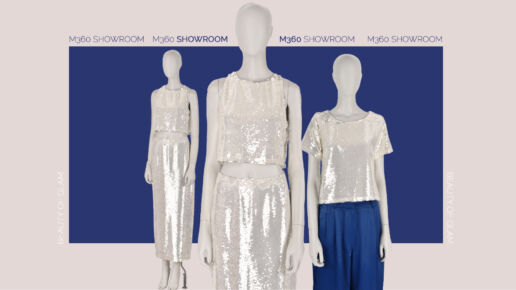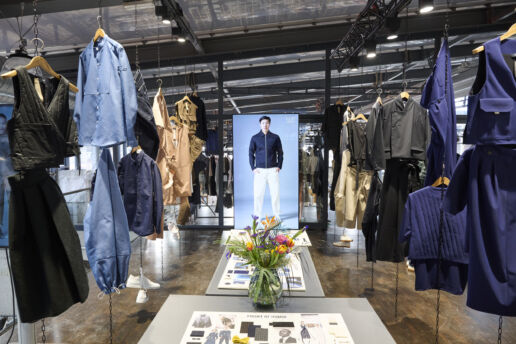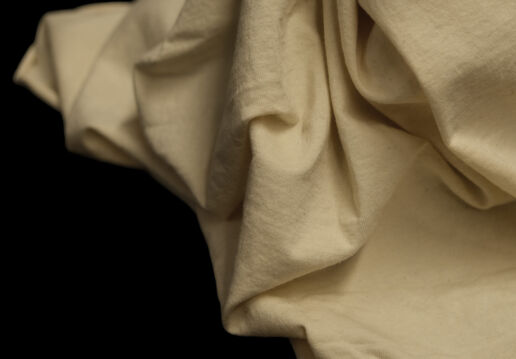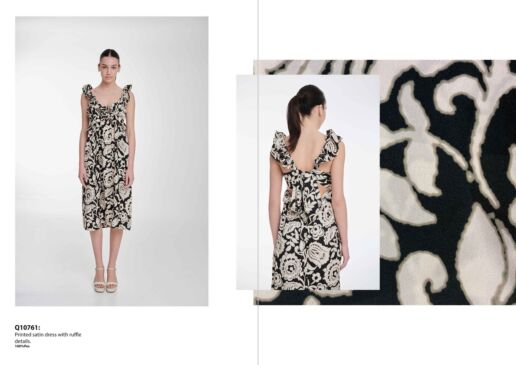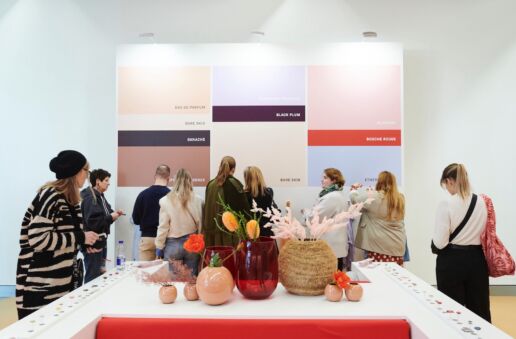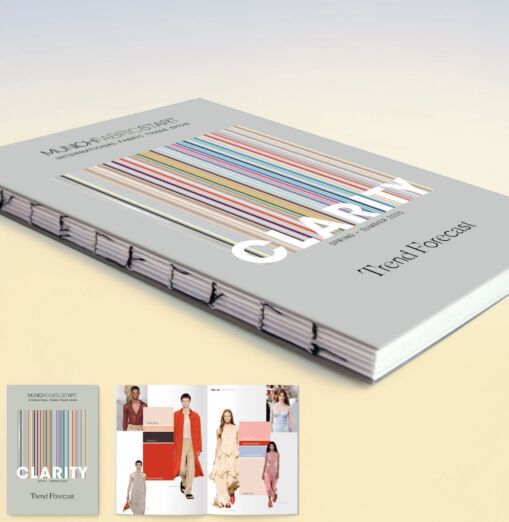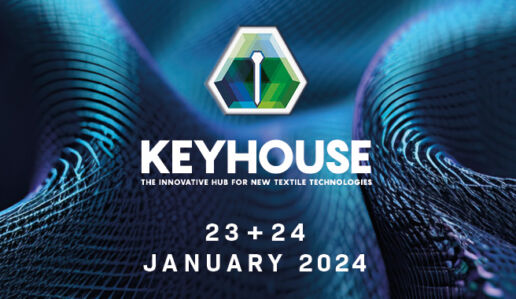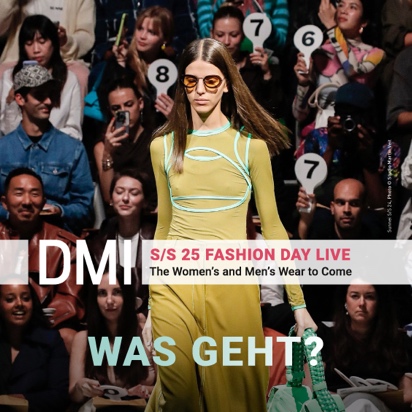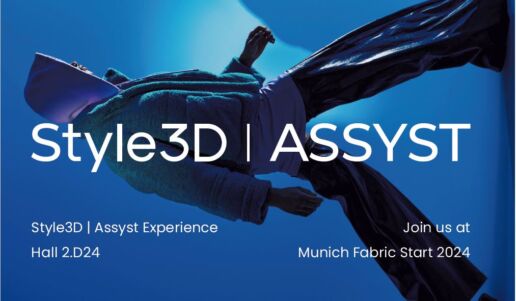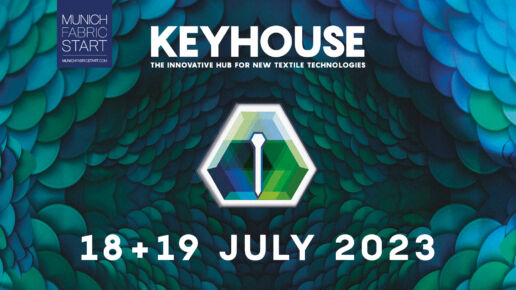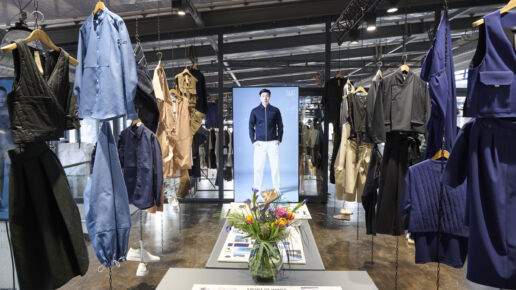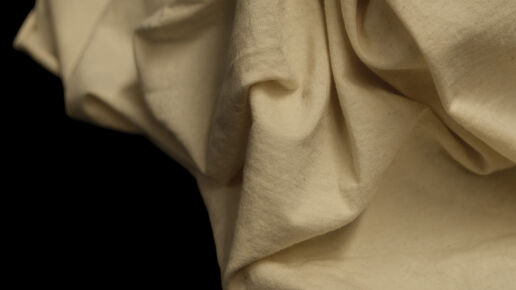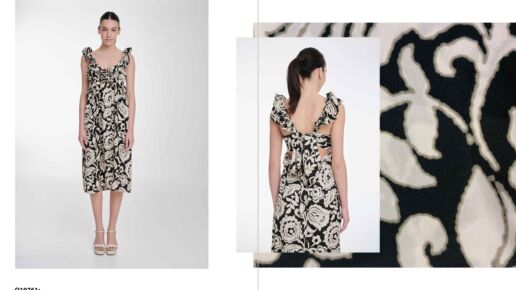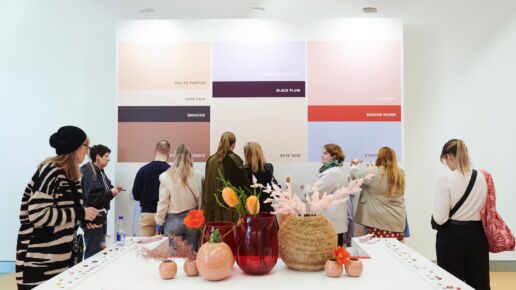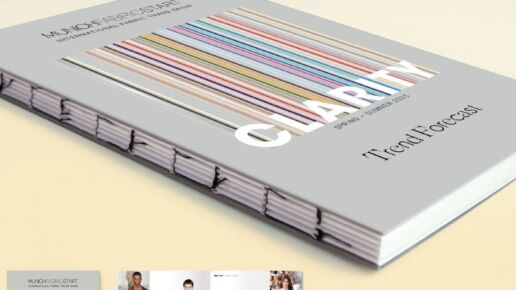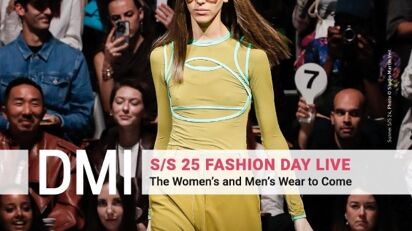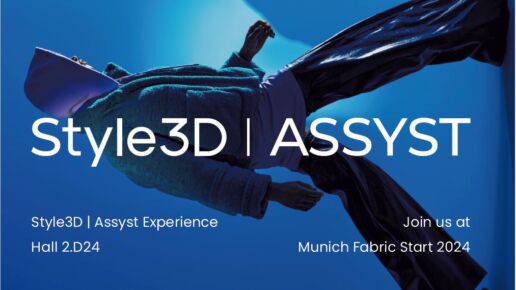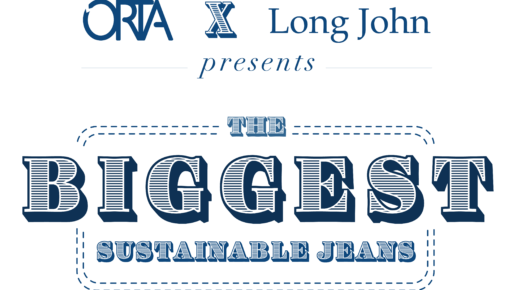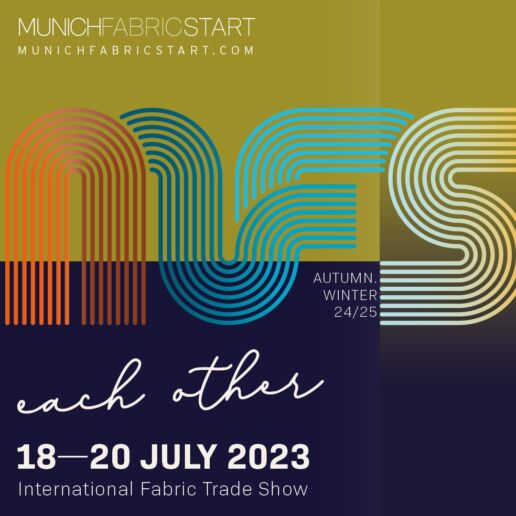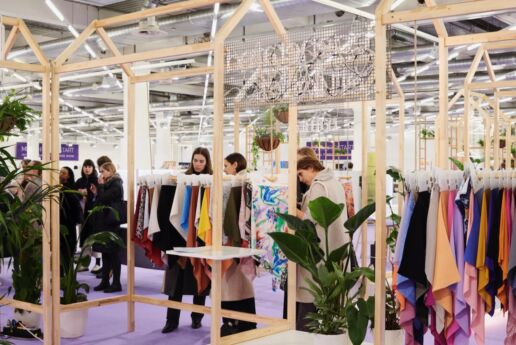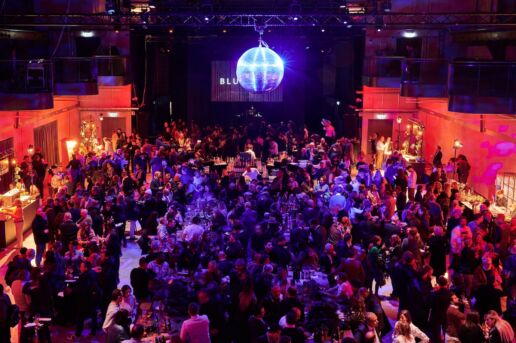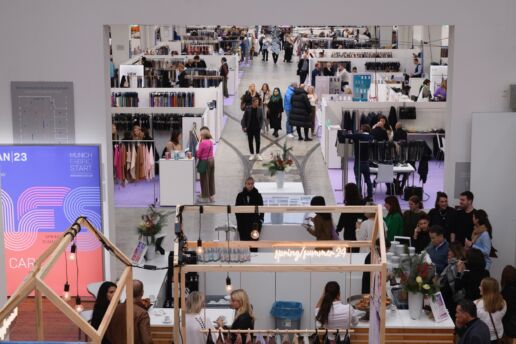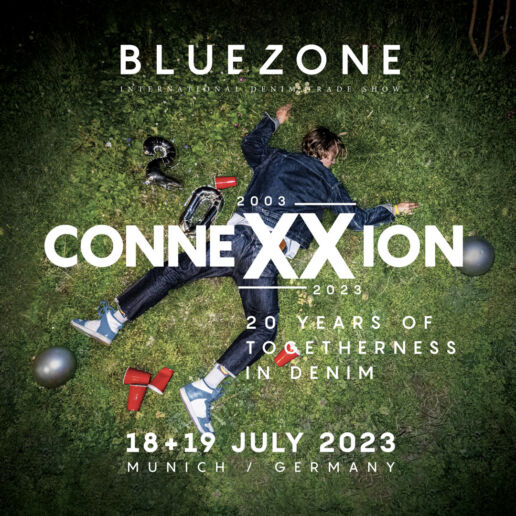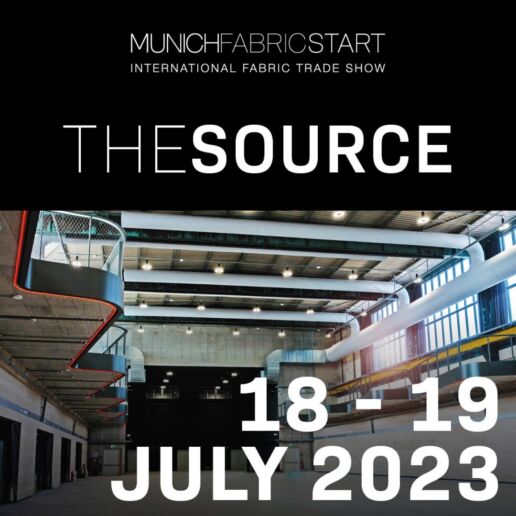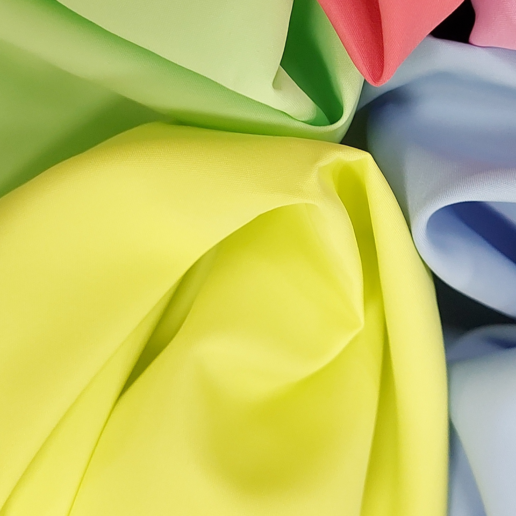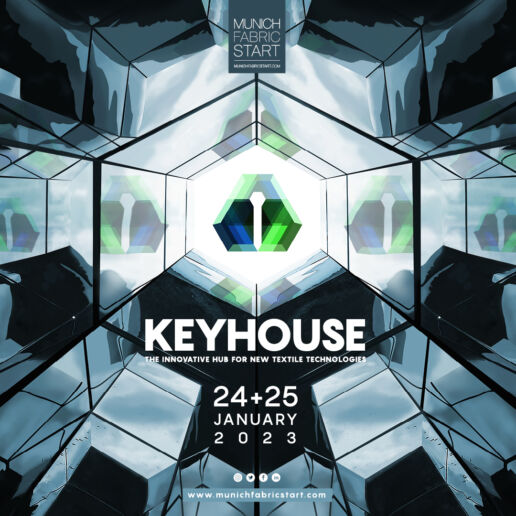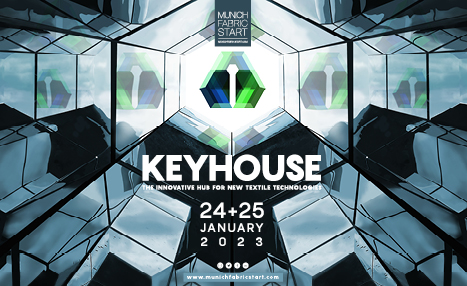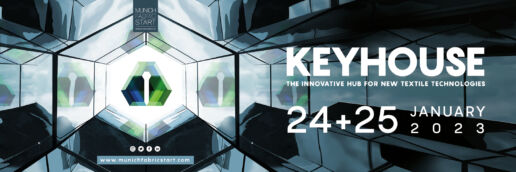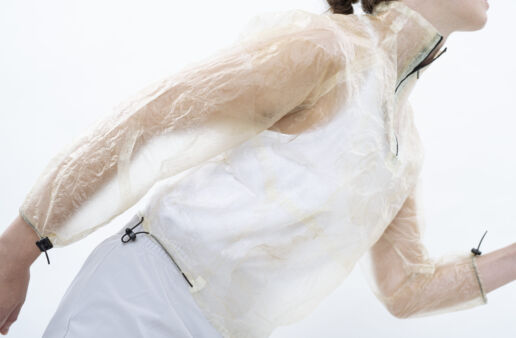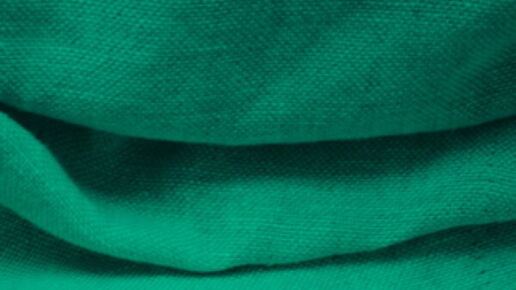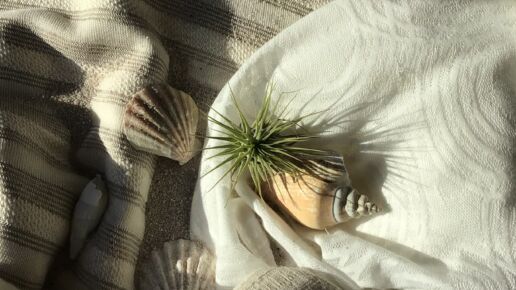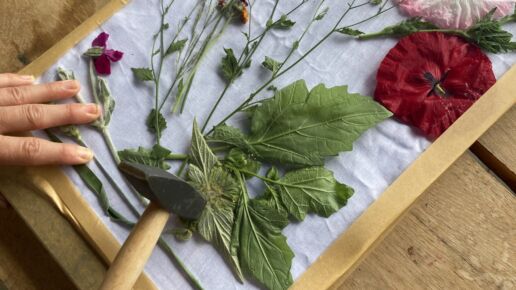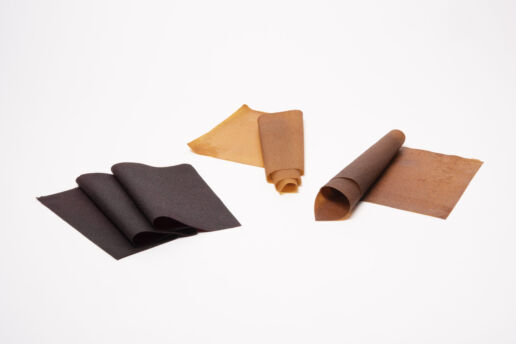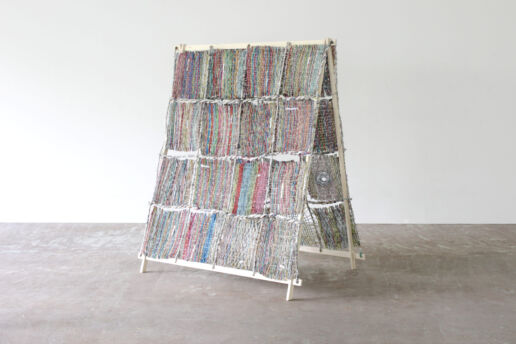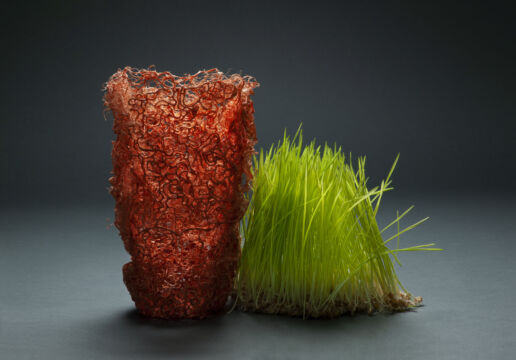Keyhouse
The Textile Industry: What to Expect in the Next Five Years
The Textile Industry: What to Expect in the Next Five Years
Guest post by Muchaneta ten Napel, Founder and CEO, Shape Innovate
The textile industry has undergone remarkable changes, shifting from the use of traditional handlooms to state-of-the-art factories that produce enormous amounts of textiles and clothing. With the quickening pace of technological advancements, shifting consumer preferences, and evolving global trends, the landscape of the textile industry is on the brink of even more significant transformations in the upcoming five years.
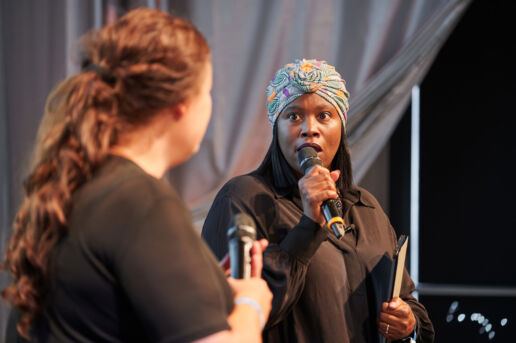
Sustainability, No Longer a Buzzword
Sustainability has evolved from a catchphrase to a prerequisite in the textile sector. The rising consciousness of consumers regarding their environmental impact has compelled textile producers to adopt eco-friendly practices. As a result, the forthcoming half-decade is expected to herald an era where sustainability is the rule, not the exception.
The focus will be reducing hazardous chemicals, water, and energy in textile production. The industry will place greater emphasis on circular production methods and using recycled materials. Brands will strive to decrease their carbon footprint while maintaining the quality and style of their products, ensuring their entire supply chain adheres to sustainability standards.
Technology, A Key Driver
Technological innovation, a key industry driver, will further shape production processes over the next five years. Automation, artificial intelligence (AI), and the Internet of Things (IoT) will redefine production efficiency. Automation will enhance efficiency, reduce manual labour, and minimise production errors, leading to quicker turnarounds, amplified production capacity, and cost reduction.
AI will enable trend prediction, production optimisation, and quality control enhancement. Textile producers will leverage AI tools to analyse data and make informed sourcing, manufacturing, and distribution decisions. By connecting devices and systems, IoT will provide the following:
- Real-time control and monitoring of production processes.
- Thus improving quality control.
- Reducing waste.
- Boosting productivity.
Demand for luxury and premium textile products will rise over the next five years. An increase in consumer financial stability and an expanding middle class in emerging markets like China and India will drive this trend. In addition, the shift in consumer behaviour due to the COVID-19 pandemic towards prioritising comfort, quality, and durability over fast fashion will likely persist.
The Rise of Local Production
The pandemic also highlighted global supply chains’ vulnerability, causing production and delivery disruptions. The coming years will see a rise in local production as brands seek to reduce dependency on foreign suppliers. This shift towards local production will bring quicker turnarounds, lower transportation costs, reduced carbon footprint, and greater control over the supply chain. It will also stimulate local economies by creating job opportunities and nurturing local textile industries.
However, local production comes with challenges, including potentially higher costs than overseas production and the need for a skilled workforce. Nevertheless, the brands that successfully adapt to these shifts and meet evolving consumer needs will flourish in the upcoming years. In addition, the textile industry’s transformation presents an opportunity to address long-standing issues such as environmental sustainability, ethical production, and supply chain transparency, promising an exciting future.
In conclusion, the textile industry is poised for a significant evolution in the next five years, propelled by consumer behaviour, global trends, and technological advancements.
The textile industry is poised for a significant transformation in the next five years. Its evolution presents an opportunity to address long-standing challenges such as environmental sustainability, ethical production, and supply chain transparency.
All in all, it is an exciting time for the textile industry, and the next five years will undoubtedly shape its future.
Are you interested in more in-depth facts and figures on the new textile economy?
Visit the Shape Innovate Lounge in H5 | 04 or attend the mini-lectures in the Keyhouse.
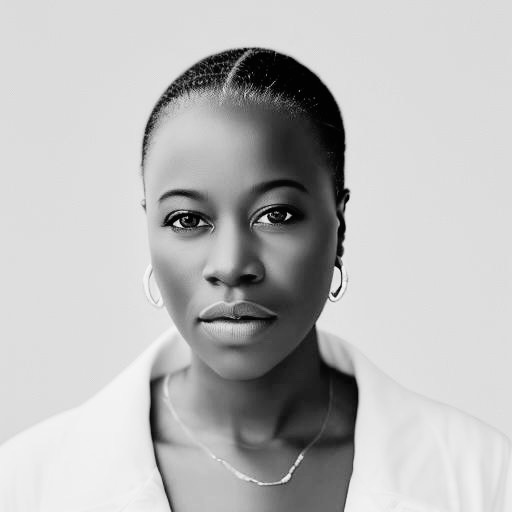
About the author
Founding editor-in-chief of Shape Innovate, Muchaneta has worked in the fashion industry for over 14 years. She is currently one of the leading influencers speaking and writing about the merger of fashion with technology and wearable technology.
Muchaneta ten Napel | m@shapeinnovate.com
THIS ALSO MIGHT BE INTERESTING FOR YOU
THE SOURCE 2024 – Spring.Summer 25 – Part II
8. February 2024
Some 30 selected clothing manufacturers present their products and services around the latest sourcing services and apparel manufacturing at THE SOURCE studio in hall 2.
SAAT MUNICH X BLUEZONE
6. February 2024
The "SIGNATURE Corporate Collection" from SAAT - a pinnacle of elegance and sophistication
CO2 Tex – Sustainable innovations
1. February 2024
CO2Tex stands out as a central project within BIOTEXFUTURE, focusing on CO2-containing thermoplastic polyurethane (TPU) as an alternative to conventional elastane.
THE SOURCE 2024 – Spring.Summer 25 – Part I
30. January 2024
Some 30 selected clothing manufacturers present their products and services around the latest sourcing services and apparel manufacturing at THE SOURCE studio in hall 2.
MUNICH FABRIC START Januar 2024 – Closing Report
26. January 2024
The essence of the meeting of the European fashion industry: we are experiencing a return to our roots to meet the growing need for orientation – supported by a variety of exciting sustainable and AI-supported solutions that can pave the way to the future for the industry.
Trend Preview for SPRING.SUMMER 25
22. January 2024
Reduction and realism, coupled with imagination and creativity, create a new awareness of quality, sustainability and design expertise.
KEYHOUSE 2024 trends spring.summer25
20. January 2024
Auf über 1.000 Quadrat-metern finden Sie richtungsweisende Smart Textiles, Future Fabrics und neue Technologien – sei es in Punkto Nachhaltigkeit, Kreislaufwirtschaft, Digitalisierung, Traceability, Technologie oder Finishing für die Saison Autumn.Winter 24/25.
TIMELY TIMELESS
18. January 2024
Langlebigkeit steht hoch im Kurs. Und damit ist nicht nur eine solidere Qualität gemeint, sondern auch und vor allem ein zeitloseres Design.
Digitale Klarheit im Design – ASSYST
16. January 2024
Für das Thema Nachhaltigkeit sind normalerweise Einkauf und Produktion zuständig. Wer aber über den Einsatz von abbaubaren Stoffen hinausdenkt, kann Kosten, Materialverbrauch und Profitabilität deutlich beeinflussen. Neu daran: Der Schlüssel dazu liegt in der Hand der Kreativen.
ORTA x Long John
13. January 2024
Togetherthey developed the biggest sustainable jeans everproduced to set a new milestone within the denim industry.
Discover the latest trends from KEYHOUSE 2023
In the atmospheric industrial charm of KEYHOUSE, Hall 5, progressive suppliers and global players from cross-industry sectors will show their latest new developments and innovations. On more than 1,000 square metres you will find trend-setting smart textiles, future fabrics and new technologies – be it in terms of sustainability, circular economy, digitalisation, traceability, technology or finishing. Staged as an interactive think tank, forward-looking show cases will be in the spotlight alongside sustainable innovations.
The KEYHOUSE is also home to the main lecture forum of MUNICH FABRIC START with exclusive keynotes, panel discussions, trend presentations, Q&A sessions and expert talks from international industry insiders. These are some of the innovative brands that presented their new products during the last KEYHOUSE Edition in July 2023.

ALGA – LIFE
Algaeing™ is all about proactively addressing apparel and textile supply chain practices, combating climate change, and capitalizing on the growing market demand for sustainable and healthy products. With an innovation that converts algae into bio-fiber and eco-friendly dye, Algaeing™ is redesigning the world of fashion and other industries for future generations. Let’s detoxify the fashion industry with Algaeing™ textile solutions!

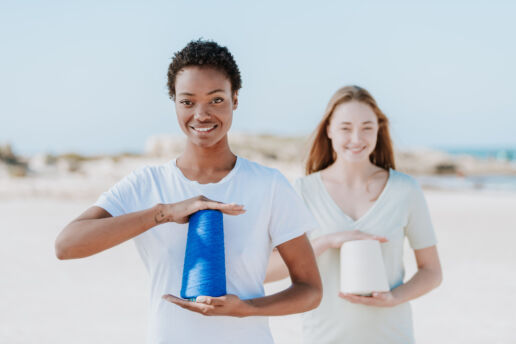
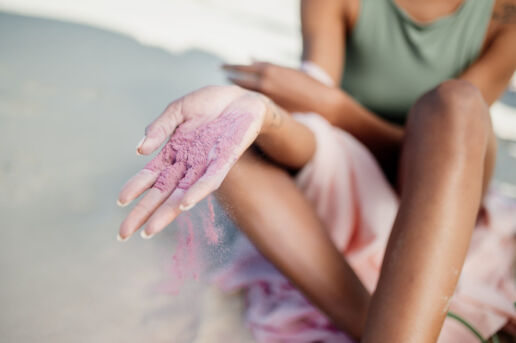
CLO Virtual Fashion
CLO Virtual Fashion, established in 2009, is a multinational technology company revolutionizing the garment industry. Utilizing their cutting-edge 3D Cloth Simulation Algorithm, they seamlessly integrate digital and physical garment components, leading the market. The transformative CLO Fabric Digitization Service converts physical fabrics into digital assets, enabling limitless design possibilities and fostering collaboration with suppliers. This service reduces costs and unlocks unparalleled creativity. With a comprehensive suite of interconnected products, including 3D garment design software, digital asset management, and consumer-facing services like virtual fitting, CLO Virtual Fashion offers users a consolidated and innovative way of designing.
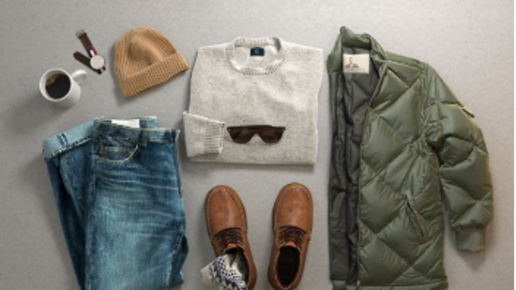

EYAND
Ecological yarn and 100% natural dying: Eyand is a registered Brand that represents the technical know-how used in the knitting and preparing of the fabrics and garment dying process using natural colors assuring the absence of chemical products. With a family tradition in textiles and more than 30 years of experience, Marti Puignou, General Manager of TIS Group and creator of the brand Eyand has invested all his efforts to offer fabrics with the maximum quality and with an ecological focus. Eyand® holds certifications such as OEKO-TEX® Standard 100, GOTS and GRS.
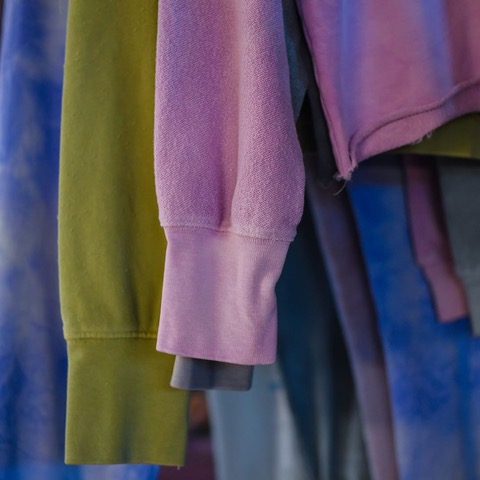
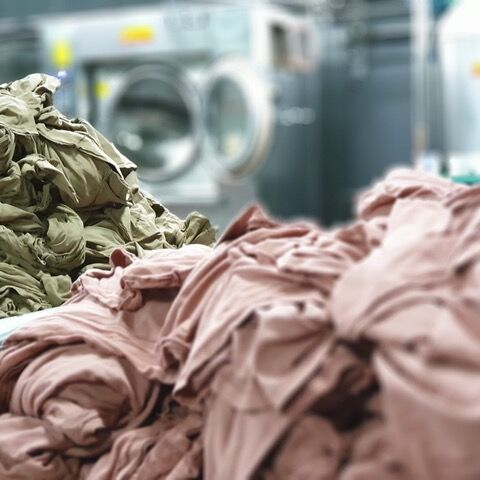
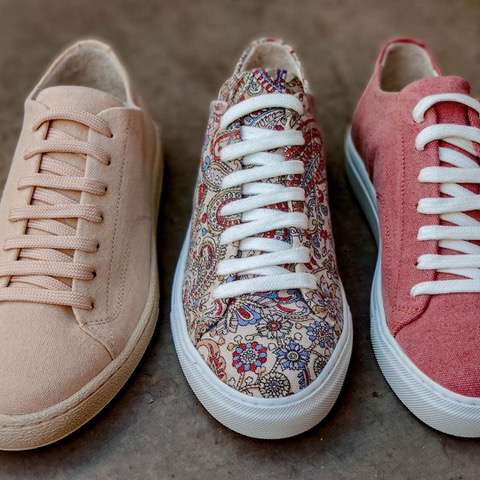
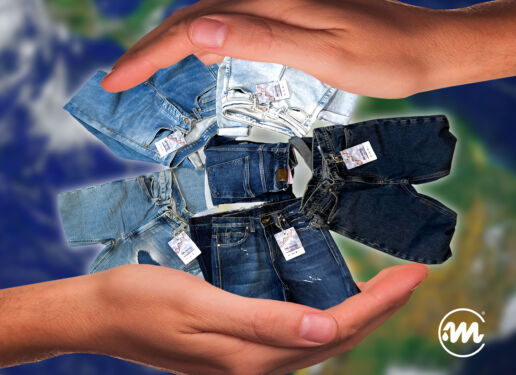
MONTEGA CHEMICAL SOLUTIONS
Montega Chemical Solutions from Italy is the leader in the production of chemicals and focuses its new research on its responsibility for a cleaner chemistry without penalize the fashion look that always inspires its new collections. Montega gives the input to continuously use the fantasy, to express the creativity without bounds realizing a sustainable art on the garment with Italian flavour.
NEW (RE)SOLUTIONS by Naveena Denim Mills
NEW (RE)SOLUTIONS is a collaborative collection exploring new solutions to design future-fit sustainable denim crafted by Naveena Denim Mills using the latest LYCRA® innovations. The collection is designed by Jac Cameron, and sustainably finished by Chantuque, the first pure sustainable laundry of Turkey. Established in Karachi, Pakistan, in 2005, Naveena Denim Mills specializes in manufacturing premium yarn and denim fabrics, constantly seeking the ultimate union of form and function through creative engineering.
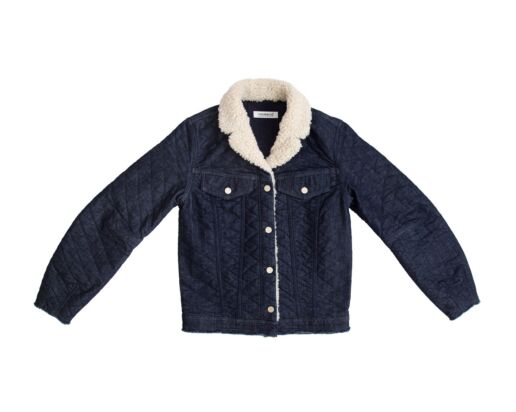
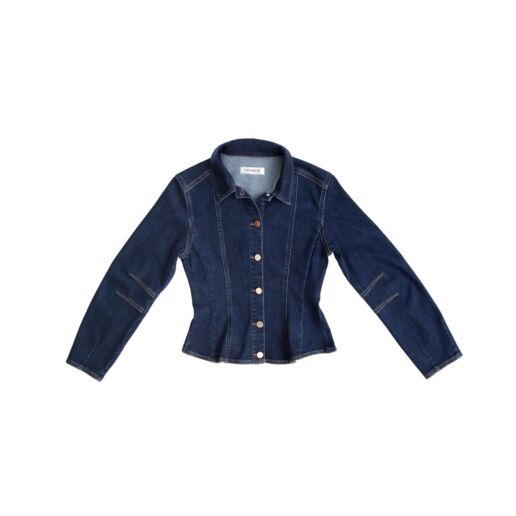
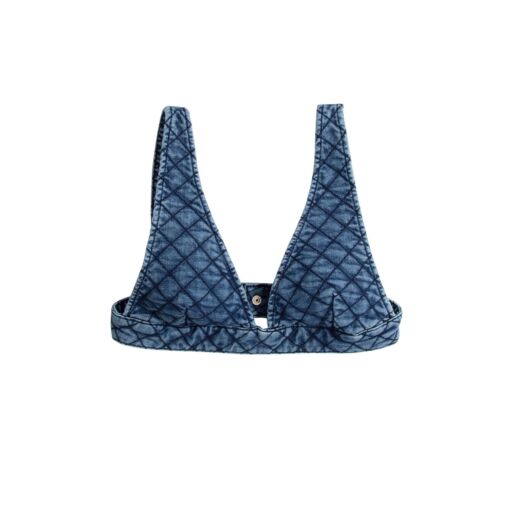
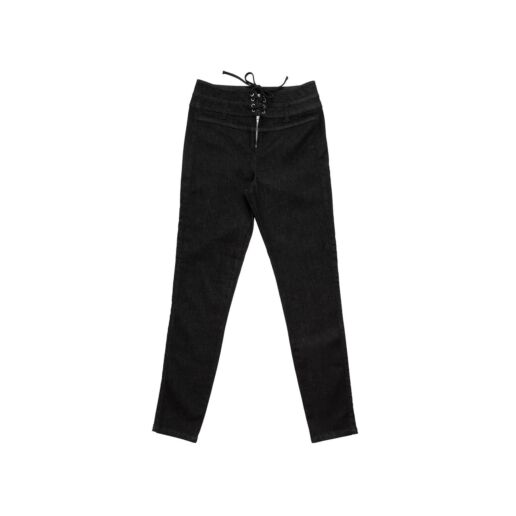
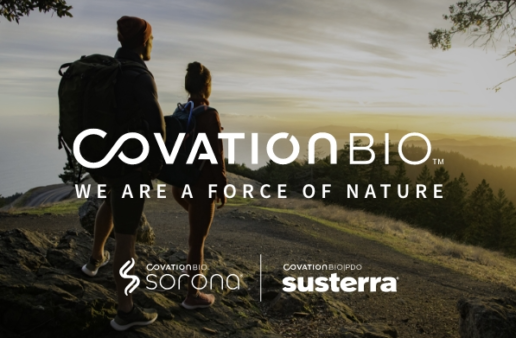
SORONA
Sorona® is a breakthrough bio-based, high-performance polymer offering unique benefits for the textile industry. It contains 37% renewable plant-based ingredients by weight and minimizes the impact on the environment without sacrificing quality and performance. Sorona® can be used in a wide range of textile applications and offers unique performance benefits, including incredible softness, long lasting stretch and recovery properties, UV and chlorine resistance, a quick dry ability, excellent resilience, color fastness, and inherent stain resistance without the need for toxical treatments. Sorona® is a USDA certified bio-based product and has received the OEKO-TEX® Standard 100 Certification and blue sign certification.

TAILORLUX
Tailorlux supports companies in realizing transparency in supply chains, circularity and product protection. IntegriTEX® is an innovative traceability system designed to ensure the authenticity, identity and blending ratios of fibers and textile products. The system is based on tracer fibers that contain inorganic luminescent pigments and can be read out by Tailorlux sensors. The patented Chopcot® Dosing Device creates the entry point for integriTEX® tracer fibers. The unit crimps and cuts filaments to staple fiber, and then doses the fiber into the material flow. Visit Tailorlux at their KEYHOUSE booth H5 | 13 to learn more about textile traceability and how it can be connected to digital solutions!
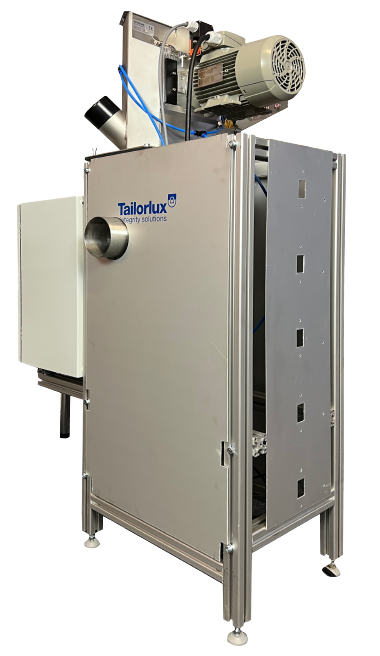
THIS MIGHT ALSO BE INTERESTING FOR YOU
THE SOURCE 2024 – Spring.Summer 25 – Part II
8. February 2024
Some 30 selected clothing manufacturers present their products and services around the latest sourcing services and apparel manufacturing at THE SOURCE studio in hall 2.
SAAT MUNICH X BLUEZONE
6. February 2024
The "SIGNATURE Corporate Collection" from SAAT - a pinnacle of elegance and sophistication
CO2 Tex – Sustainable innovations
1. February 2024
CO2Tex stands out as a central project within BIOTEXFUTURE, focusing on CO2-containing thermoplastic polyurethane (TPU) as an alternative to conventional elastane.
THE SOURCE 2024 – Spring.Summer 25 – Part I
30. January 2024
Some 30 selected clothing manufacturers present their products and services around the latest sourcing services and apparel manufacturing at THE SOURCE studio in hall 2.
MUNICH FABRIC START Januar 2024 – Closing Report
26. January 2024
The essence of the meeting of the European fashion industry: we are experiencing a return to our roots to meet the growing need for orientation – supported by a variety of exciting sustainable and AI-supported solutions that can pave the way to the future for the industry.
Trend Preview for SPRING.SUMMER 25
22. January 2024
Reduction and realism, coupled with imagination and creativity, create a new awareness of quality, sustainability and design expertise.
KEYHOUSE 2024 trends spring.summer25
20. January 2024
Auf über 1.000 Quadrat-metern finden Sie richtungsweisende Smart Textiles, Future Fabrics und neue Technologien – sei es in Punkto Nachhaltigkeit, Kreislaufwirtschaft, Digitalisierung, Traceability, Technologie oder Finishing für die Saison Autumn.Winter 24/25.
TIMELY TIMELESS
18. January 2024
Langlebigkeit steht hoch im Kurs. Und damit ist nicht nur eine solidere Qualität gemeint, sondern auch und vor allem ein zeitloseres Design.
Digitale Klarheit im Design – ASSYST
16. January 2024
Für das Thema Nachhaltigkeit sind normalerweise Einkauf und Produktion zuständig. Wer aber über den Einsatz von abbaubaren Stoffen hinausdenkt, kann Kosten, Materialverbrauch und Profitabilität deutlich beeinflussen. Neu daran: Der Schlüssel dazu liegt in der Hand der Kreativen.
ORTA x Long John
13. January 2024
Togetherthey developed the biggest sustainable jeans everproduced to set a new milestone within the denim industry.
NEW DATES VIEW and MUNICH FABRIC START
A strong start to the season in July, order decisions at short notice in September
MUNICH FABRIC START Exhibitions GmbH offers one thing above all with the positioning of its trade show formats in terms of dates and content for sourcing for Autumn.Winter 24/25: full flexibility.
In future, the July date will be used by the international fabric trade show MUNICH FABRIC START with KEYHOUSE, THE SOURCE and BLUEZONE as an impulse generator; the September date will remain an important time for follow-ups and for picking up on new and short-term market developments with reVIEW, the new concept of the VIEW PREMIUM SELECTION.
With a current booking level of almost 90% for the international fabric trade show MUNICH FABRIC START, KEYHOUSE, THE SOURCE and BLUEZONE, Munich Fabric Start Exhibitions GmbH is starting the new season for Autumn.Winter 24/25 on a strong footing. From the organisers’ point of view, the main reason for the high level of acceptance from internationally important fabric and trim exhibitors, renowned agencies, top European weavers and textile designers is the rebalancing of the July dates.
Previously, the VIEW PREMIUM SELECTION had taken place at the end of June/beginning of July with a selective choice of high-quality fabric and accessories collections. From 18 to 20 July 2023, the Munich-based trade show organiser will now successfully occupy the early date for the first time with the full power as one of Europe’s leading fabric trade shows: the international fabric trade show MUNICH FABRIC START (18 to 20 July), the innovation hub KEYHOUSE, the one-stop sourcing platform THE SOURCE and the international denim trade show BLUEZONE (18 and 19 July) will move ahead and at the same time increase their relevance in the international trade show scene.
For a large part of the visitors, the earlier date is closer to the collection rhythms and offers more time for further developments. Same goes for the BLUEZONE community and the denim business anyway – the approval for the July date could hardly be greater, which makes the organisers particularly happy on the occasion of the 20th anniversary of BLUEZONE as the first denim dedicated trade show.
Important exhibitors – including returnees – such as Ballesio, Cadica, Discovery Denim, East & Silk, Fauck, Lanificio Campore, Mapel, Naveena Denim, Pricoh’s, Sintopel, Sourcetextile, Studio 9, Taiwan Textile Federation and YKK as well as new entries like Esdigital, IBERIS Lda, Jeanius, Jersey Print Factory, Lucky Textile Group, Marjomotex, Neelams Itl, Splash by Lo, Victor Texteis or Wouters have already confirmed their participation along with many others.
“The strongest and most professional trade show for our segment clearly accommodates our development traits with its date. This date is much closer to our rhythms and, with its strong exhibitor portfolio, MFS has considerably more influence on the creation of our collections.
Especially for Bluezone – a unique, creative and inspiring space for us every time – the date is very convenient as it offers more time for washing developments and creative elaborations. With their ideas and implementations, the MFS & Bluezone team always has its finger on the pulse of time which enables us to incorporate additional inspirations into our work”
Michael Seiter, Head of Product Division Denim & Chino, HOLY FASHION GROUP
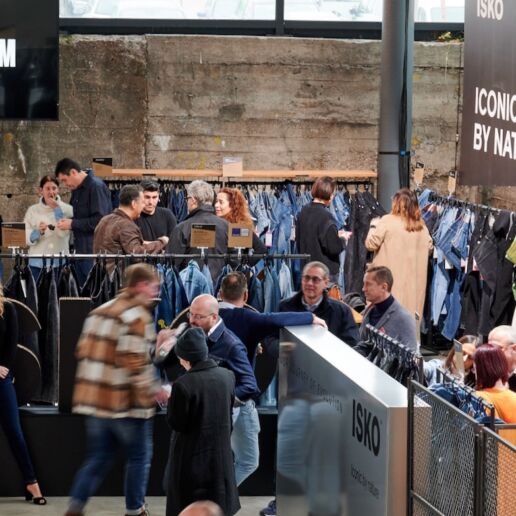
What’s new?
Due to the early date of MUNICH FABRIC START and BLUEZONE, the Munich trade show duo with KEYHOUSE and THE SOURCE formats will function even more strongly as an impulse generator and leading international event. The Munich location will also be strengthened by the relocation of the DMI Fashion Day from Düsseldorf to the Bavarian capital. In order to create maximum synergies in terms of travel times and travel costs, the first DMI FASHION DAY LIVE after the pandemic-related interruption will take place the day before the next MUNICH FABRIC START at the MOC.
The course will also be set anew in September: The date, which remains important for the industry, will in future be occupied by reVIEW – the new format of the VIEW PREMIUM SELECTION for follow-ups and highly topical, short-term trends as well as new market developments. On an area of around 2,500 square metres, the first reVIEW Autumn.Winter 24/25 will be held on 13 and 14 September 2023 on the Zenith grounds in Motorworld. With its gigantic dimensions and spectacular architecture, the listed location is one of the largest cantilevered historic steel halls in Europe.
“Trends are short-term and more fast-moving than ever. The presentation and ordering rhythms are constantly shifting. There is no one right time. With two highly relevant dates in July and September, we offer the market security and reliability on the one hand and full flexibility on the other”
Sebastian Klinder, Managing Director MUNICH FABRIC START Exhibitions GmbH
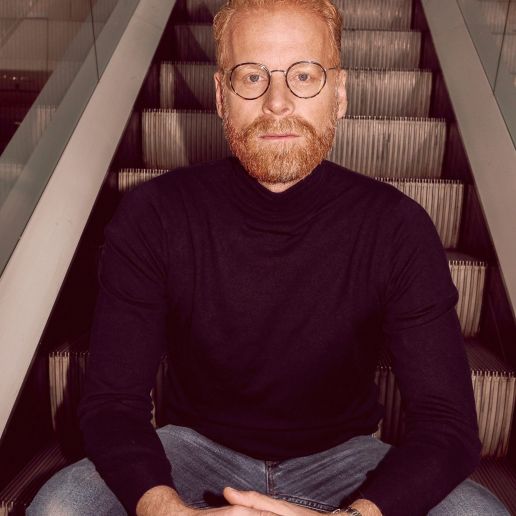

“The feedback from the textile industry as well as from international brands confirms that we have placed the right offer. Both events have great potential and complement each other perfectly. We support the market by offering the right platform at the right time to bring the relevant players together. And we do this without overlapping with other international trade show formats of the fashion business.”
Frank Junker, Creative Director der Munich Fabric Start Exhibitions GmbH
Strong encouragement from the fashion industry
The response is extremely positive, not only from exhibitors but also from international designers, product managers and buyers. In a tense market situation, MUNICH FABRIC START shows strength, forwardlookingness and reliability. MUNICH FABRIC START is the start of the new season and the most important show for early trend information.
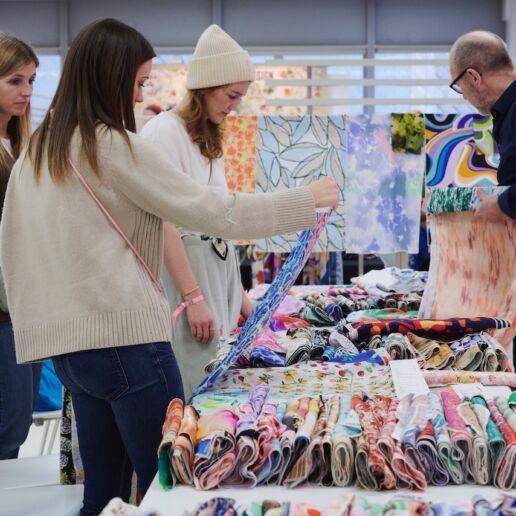
“The MUNICH FABRIC START is of great importance for our work – to be more precise, it is indispensable!
The earlier the deadline, the first input for the new collection, the more precise and pointed the result.
The reVIEW also remains relevant at the new, later date and supports our dynamic design process.”
Katerina Grigoriadis, Head of Design DayDream, MAC Mode GmbH & Co KGaA
“For our team, the new season starts with the MFS. We always take our inspiration from the colours, the forum and the exhibitors and work out our concepts for the collections accordingly. The exchange with producers and exhibitors is also indispensable and both,
MFS and View are a great platform to do so.
We discuss new themes but also previous orders. Meeting everyone at the same time and place in person is a great added value for our cooperation. In the past, we did this in Paris at PV, however this has been completely replaced by MFS.”
Tülay Önder, Head of Product Design, HALLHUBER
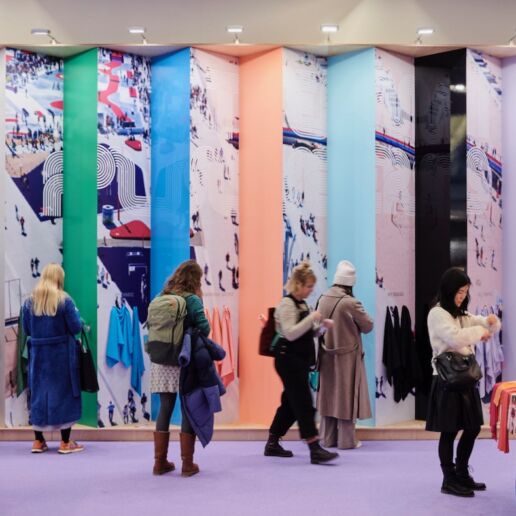
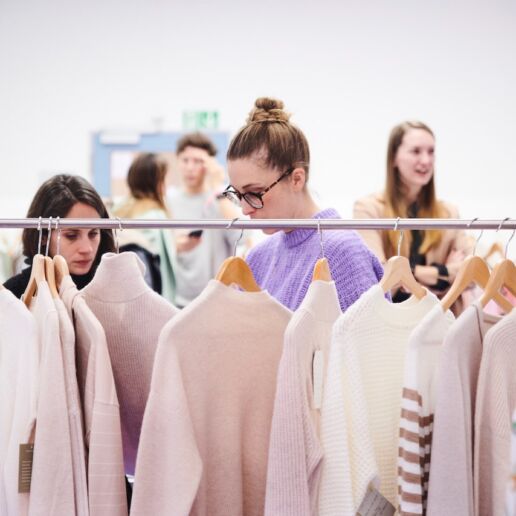
“For us, Munich Fabric Start is the most important trade show for preliminary information, for aligning the collection and for matching materials. Next to Milano Unica, it is the most important sourcing show. We welcome the earlier date of Munich Fabric Start very much. Instead of View, it will now be the most important show for us to get information early. We are excited about the process and are looking forward to it.”
Gerhard Kränzle, CEO, HILTL Hosen-Manufaktur GmbH
“The Munich Fabric Start is always an important milestone in our collection development. We are particularly interested in the trend themes and colours, which we compare with our developments to confirm or adapt them accordingly.
We are very keen to attend lectures on relevant topics such as sustainability, CAD, fair labour standards and always look forward to meeting your stars like Li Edelkoort.
The earlier date suits us very well. As knitters we already start with the new colours mid-May so the new date actually fits better into our schedule. A visit to the VIEW is a must in any development process. Since it will now take place in September, we will definitely visit this small and fine.”
Melanie Geyer, Senior Designer Knitwear, MAERZ München
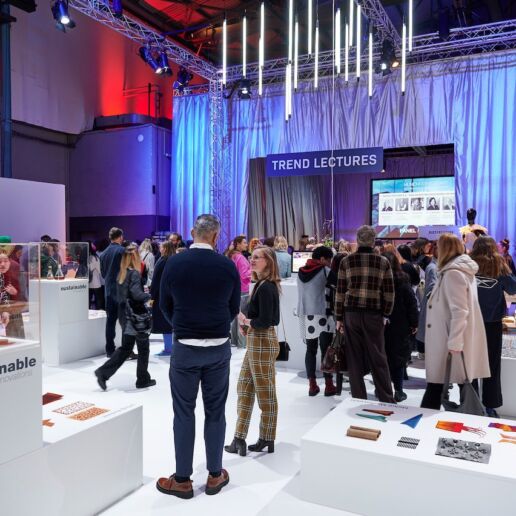
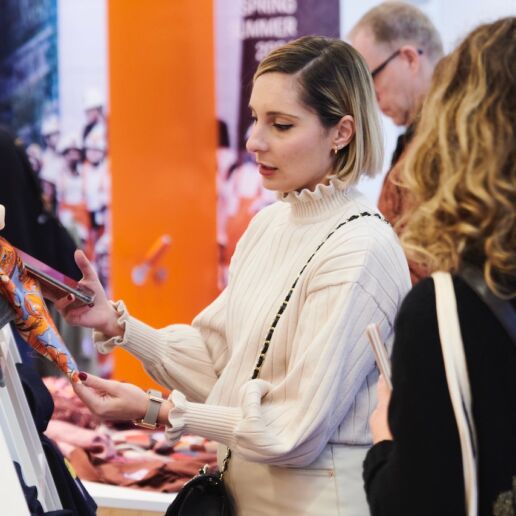
“In my point of view, the early date is a meaningful step. I am pleased about the early overview & choice of collections. I also welcome the fact that flat weave and denim suppliers are brought together at this time. The September event has to prove itself and depends on the new & further developments of the collections. We appreciate both events to date and will continue to use them in the future.”
Michael Willems, Produktmanager, ALBERTO GmbH & Co. KG
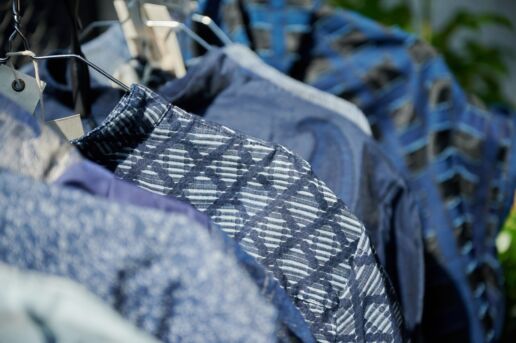
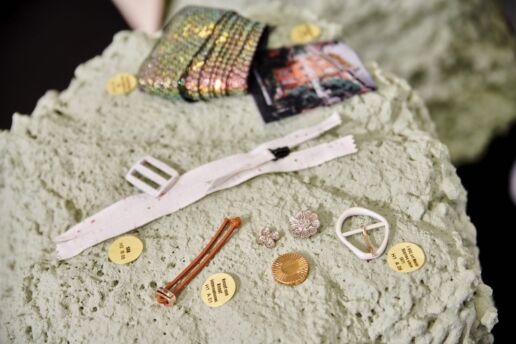
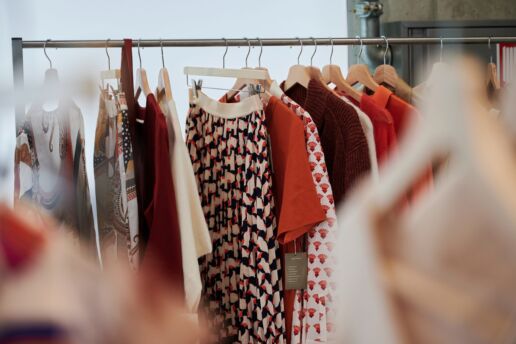
OVERVIEW OF ALL UPCOMING DATES
AUTUMN.WINTER 24/25
MUNICH FABRIC START
(18. – 20.07.2023)
BLUEZONE, KEYHOUSE, THESOURCE
(18. – 19.07.2023)
AUTUMN.WINTER 24/25
reVIEW
(13. & 14.09.2023)
SPRING.SUMMER 25
preVIEW
(28. & 29.11.2023)
SPRING.SUMMER 25
MUNICH FABRIC START | THE SOURCE Studios
(23. – 25.01.2024)
BLUEZONE | KEYHOUSE
(23. – 24.01.2024)
Discover more industry-changing innovations at our upcoming trade shows:
Fabrics Spring.Summer 24 I
In the FABRICS Area, around 600 international suppliers present their material innovations for all apparel segments. The complete product portfolio of fashionable woven and knitted fabrics made of wool, cotton, silk, blends and functional fibers is represented here. For the Spring.Summer 24 season, we present some highlights from international producers in our FABRICS blogposts:
ATHENEA
Athenea is much more than just a family textile company founded in 1976 in Alicante, Spain. Athenea has managed to keep all the production process internal, which allows them to be recognised as a vertical factory with the ability to develop qualities, print (digital as well as conventional), dye and finish. There’s no limitation in the number of colours nor the scale of the designs. They can 100% personalise the designs following their clients’ specifications, therefore creating unique and exclusive designs.
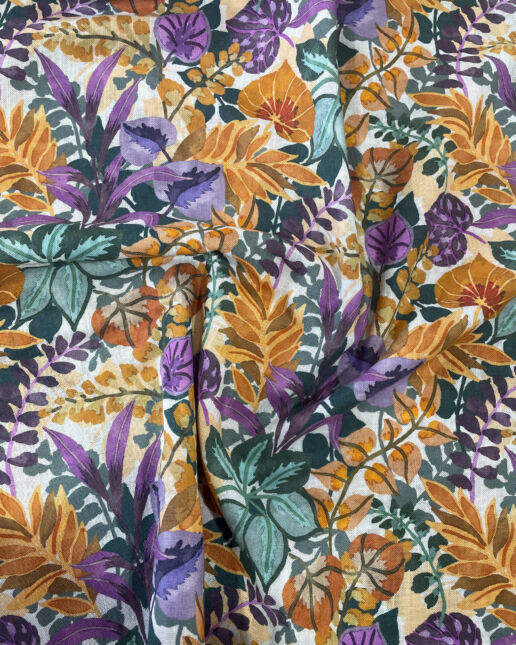
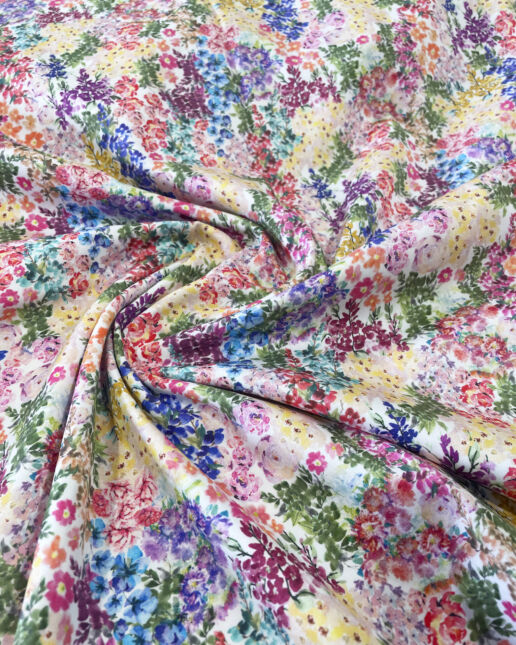
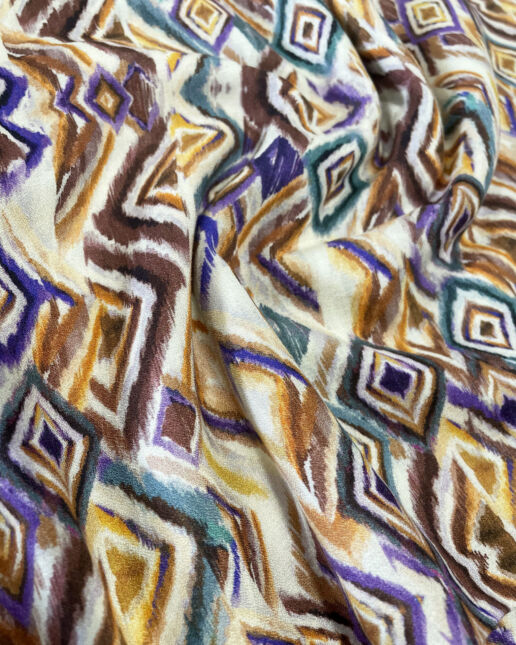
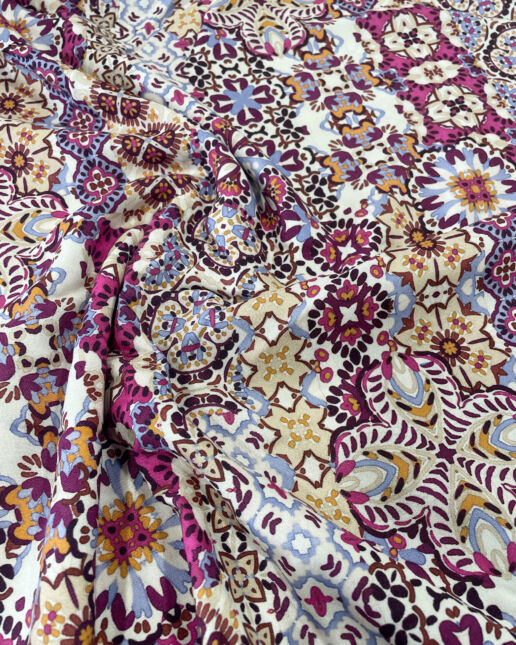
BOGAZICI ORME
Bogazici Orme is one of the industry’s leading companies which is specialized in producing / exporting jacquard knitted fabrics since 2006.
Developing new items before client request, delivery on time, invest in research and development are the principles lead us to success. They serve their passion, high quality and trust to their clients.
The collection offers recycled polyester / organic cotton and other eco-friendly materials. Furthermore a wide range of fancy yarn development is available and they are able to produce for Inditex and Join life.
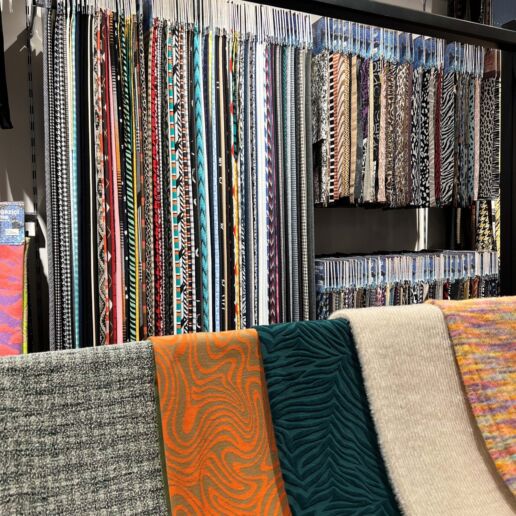
GLOBAL TEXTILE
Global Textile is one of the largest textile companies in the Republic of Uzbekistan, specializing in Yarn and Knit fabrics.
The company started operations in 2018 and is now vertically integrated in the production of textiles, from growing cotton to production of garments and apparel. The company grows its own cotton with the latest drip irrigation technology, has its own cotton processing plants, the largest spinning mills in Uzbekistan located in Tashkent and Fergana, including knitting and dyeing houses in Fergana. They have ISO, Usterized, Oeko-tex certificates, that confirm the quality, safety and environmental properties of their products.
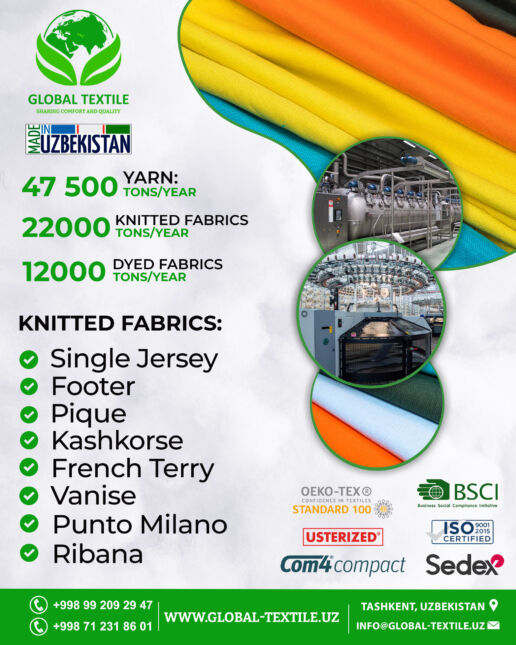
THIS MIGHT BE ALSO INTERESTING FOR YOU
THE SOURCE 2024 – Spring.Summer 25 – Part II
8. February 2024
Some 30 selected clothing manufacturers present their products and services around the latest sourcing services and apparel manufacturing at THE SOURCE studio in hall 2.
SAAT MUNICH X BLUEZONE
6. February 2024
The "SIGNATURE Corporate Collection" from SAAT - a pinnacle of elegance and sophistication
CO2 Tex – Sustainable innovations
1. February 2024
CO2Tex stands out as a central project within BIOTEXFUTURE, focusing on CO2-containing thermoplastic polyurethane (TPU) as an alternative to conventional elastane.
THE SOURCE 2024 – Spring.Summer 25 – Part I
30. January 2024
Some 30 selected clothing manufacturers present their products and services around the latest sourcing services and apparel manufacturing at THE SOURCE studio in hall 2.
MUNICH FABRIC START Januar 2024 – Closing Report
26. January 2024
The essence of the meeting of the European fashion industry: we are experiencing a return to our roots to meet the growing need for orientation – supported by a variety of exciting sustainable and AI-supported solutions that can pave the way to the future for the industry.
Trend Preview for SPRING.SUMMER 25
22. January 2024
Reduction and realism, coupled with imagination and creativity, create a new awareness of quality, sustainability and design expertise.
KEYHOUSE 2024 trends spring.summer25
20. January 2024
Auf über 1.000 Quadrat-metern finden Sie richtungsweisende Smart Textiles, Future Fabrics und neue Technologien – sei es in Punkto Nachhaltigkeit, Kreislaufwirtschaft, Digitalisierung, Traceability, Technologie oder Finishing für die Saison Autumn.Winter 24/25.
TIMELY TIMELESS
18. January 2024
Langlebigkeit steht hoch im Kurs. Und damit ist nicht nur eine solidere Qualität gemeint, sondern auch und vor allem ein zeitloseres Design.
Digitale Klarheit im Design – ASSYST
16. January 2024
Für das Thema Nachhaltigkeit sind normalerweise Einkauf und Produktion zuständig. Wer aber über den Einsatz von abbaubaren Stoffen hinausdenkt, kann Kosten, Materialverbrauch und Profitabilität deutlich beeinflussen. Neu daran: Der Schlüssel dazu liegt in der Hand der Kreativen.
ORTA x Long John
13. January 2024
Togetherthey developed the biggest sustainable jeans everproduced to set a new milestone within the denim industry.
KEYHOUSE 2023
Im atmosphärischen Industriecharme des KEYHOUSE, der Halle 5, zeigen progressive Anbieter und Global Player aus branchenübergreifenden Bereichen ihre aktuellen Neuentwicklungen und Innovationen. Auf über 1.000 Quadratmetern finden Sie richtungsweisende Smart Textiles, Future Fabrics und neue Technologien – sei es in Punkto Nachhaltigkeit, Kreislaufwirtschaft, Digitalisierung, Traceability, Technologie oder Finishing. Inszeniert als interaktiver Think Tank stehen zukunftsweisende Show Cases neben Sustainable Innovations im Spotlight.
Im KEYHOUSE befindet sich auch das Hauptvortragsforum der MUNICH FABRIC START mit exklusiven Keynotes, Podiumsdiskussionen, Trend Präsentationen, Q&A Sessions & Experten-Talks internationaler Branchen-Insider. Dies sind einige der innovativen Brands, die ihre Neuheiten während der letzten KEYHOUSE Edition im Januar 2023 präsentiert haben.
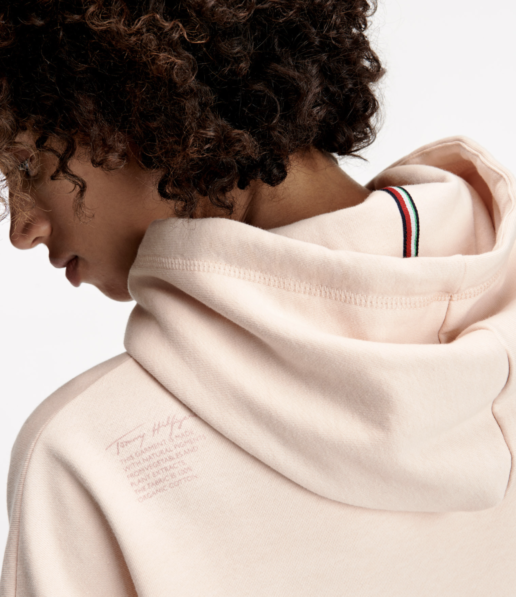
FICUS INNOVATIONS
Stellen Sie sich eine Technologie zum Färben von Textilien vor, die im Vergleich zu herkömmlichen Reaktivfärbemethoden mehr als 50 % Wasser und Energie spart. Stellen Sie sich außerdem vor, dass sie natürliche Pflanzenabfallextrakte als Farbstoffe und Hilfsstoffe für alle Vor- und Nachbehandlungs- und Färbeprozesse verwendet. Ficus Innovations hat seine einzigartige Technologie zum Färben von Naturstoffen nach 7 Jahren R&D entwickelt. Ziel ist es, natürliche Ressourcen zu schützen und wiederherzustellen, indem die Einführung nachhaltiger Stofffärbe-, Druck- und Veredelungsprozesse beschleunigt wird.
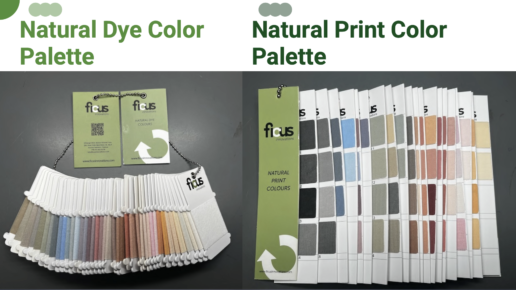
KAISER & DYSTAR
Der türkische Laundry-Anbieter Kaiser hat kürzlich das Advanced Used-Look-Konzept für modische Wash-Down-Effekte lanciert. Dieses Verfahren nutzt einzigartige und nachhaltigere Methoden, um mit einer neuen Farbstoffgruppe namens Lava Dye OZN einen Used-Look auf farbigen Kleidungsstücken zu erzielen. Das Advanced Used Look-Konzept biete eine einzigartige Lösung für die Probleme des Marktes in Bezug auf Kosten, Echtheit, Reproduzierbarkeit und Nachhaltigkeit bei used Non-Denim-Looks mit wasserlosen Methoden und der speziellen DyStar-Chemie.
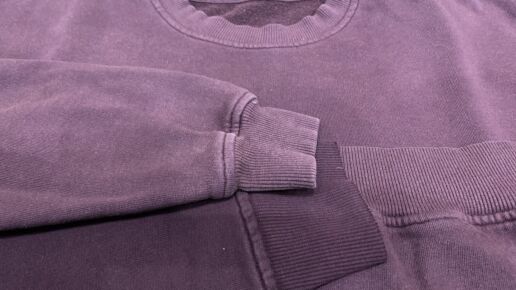
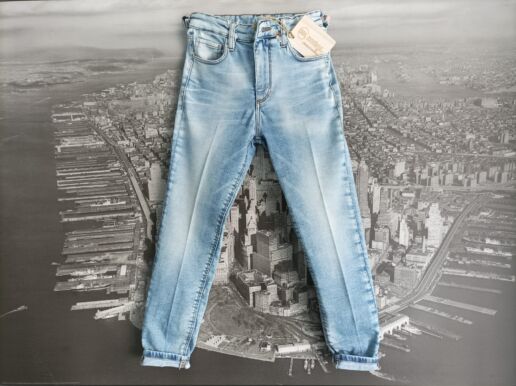
MONTEGA
Rapid Dry ist das revolutionäre Produkt von Montega, das den Trocknungsprozess verkürzt und einen Mehrwert für das fertige Kleidungsstück schafft. Dank seiner speziellen Formel ermöglicht Rapid Dry eine schnellere Verdunstung des Wassers in der Faser, Energieeinsparung während der Trocknungsphase und folglich niedrigere Kosten für den gesamten Prozess, wodurch ein saubereres Kleidungsstück mit weniger Verschleiß erzielt wird.
REACTIVE REALITY
Reactive Reality ist der führende Anbieter von Technologien zur virtuellen Anprobe und zur Erzeugung virtueller Modebilder. Die PICTOFiT-Plattform ermöglicht es Modemarken und Einzelhändlern, virtuelle Umkleidekabinen und fotorealistische Avatare nahtlos in ihre Website, App und In-Store-Lösungen zu integrieren. Für Verbraucher erstellt die Plattform fotorealistische Avatare von Käufern, die genaue Größenempfehlungen für alle Marken ermöglichen. Die Avatare können interaktiv eingekleidet werden und bieten unbegrenzte Outfit-Kombinationen und virtuelle Hintergrundszenen.
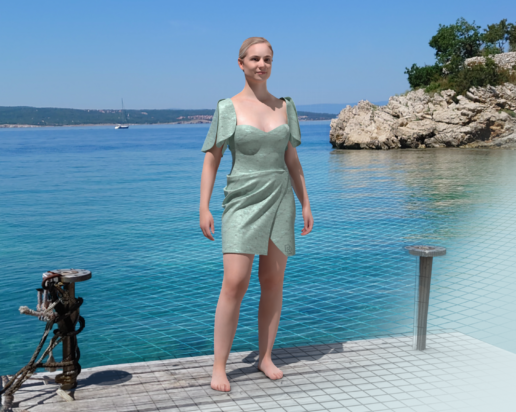
TORAY INTERNATIONAL EUROPE
Toray ist ein integrierter Chemiekonzern, der seine Geschäftstätigkeit in 29 Ländern und Regionen weltweit ausübt. Das 1926 gegründete Unternehmen ist ein weltweit führender Hersteller von fortschrittlichen Materialien und ein Lösungsanbieter mit Schwerpunkt auf Fasern, Textilien und Bekleidung.
Das könnte Sie auch interessieren
THE SOURCE 2024 – Spring.Summer 25 – Part II
8. February 2024
Some 30 selected clothing manufacturers present their products and services around the latest sourcing services and apparel manufacturing at THE SOURCE studio in hall 2.
SAAT MUNICH X BLUEZONE
6. February 2024
The "SIGNATURE Corporate Collection" from SAAT - a pinnacle of elegance and sophistication
CO2 Tex – Sustainable innovations
1. February 2024
CO2Tex stands out as a central project within BIOTEXFUTURE, focusing on CO2-containing thermoplastic polyurethane (TPU) as an alternative to conventional elastane.
THE SOURCE 2024 – Spring.Summer 25 – Part I
30. January 2024
Some 30 selected clothing manufacturers present their products and services around the latest sourcing services and apparel manufacturing at THE SOURCE studio in hall 2.
MUNICH FABRIC START Januar 2024 – Closing Report
26. January 2024
The essence of the meeting of the European fashion industry: we are experiencing a return to our roots to meet the growing need for orientation – supported by a variety of exciting sustainable and AI-supported solutions that can pave the way to the future for the industry.
Trend Preview for SPRING.SUMMER 25
22. January 2024
Reduction and realism, coupled with imagination and creativity, create a new awareness of quality, sustainability and design expertise.
KEYHOUSE 2024 trends spring.summer25
20. January 2024
Auf über 1.000 Quadrat-metern finden Sie richtungsweisende Smart Textiles, Future Fabrics und neue Technologien – sei es in Punkto Nachhaltigkeit, Kreislaufwirtschaft, Digitalisierung, Traceability, Technologie oder Finishing für die Saison Autumn.Winter 24/25.
TIMELY TIMELESS
18. January 2024
Langlebigkeit steht hoch im Kurs. Und damit ist nicht nur eine solidere Qualität gemeint, sondern auch und vor allem ein zeitloseres Design.
Digitale Klarheit im Design – ASSYST
16. January 2024
Für das Thema Nachhaltigkeit sind normalerweise Einkauf und Produktion zuständig. Wer aber über den Einsatz von abbaubaren Stoffen hinausdenkt, kann Kosten, Materialverbrauch und Profitabilität deutlich beeinflussen. Neu daran: Der Schlüssel dazu liegt in der Hand der Kreativen.
ORTA x Long John
13. January 2024
Togetherthey developed the biggest sustainable jeans everproduced to set a new milestone within the denim industry.
100 % collagen, 0 % plastic - Sustainable innovations
100 % collagen, 0 % plastic
GOLD by WINT Design Lab Robin Hoske and Felix Rasehorn
Sustainable Innovations
If you think that “GOLD” by WINT Design Lab was inspired by the shiny precious metal, you’re wrong – the design research project draws its inspiration from the outer tissue layer of the cow’s intestine. This extremely thin, elastic and tear-resistant membrane, also called gold beater’s skin, was used in the past as a separating layer when beating gold leaf.
Product designers Robin Hoske and Felix Rasehorn, founders of WINT Design Lab, together with Mimotype Technologies, saw the potential in the material to create durable and recyclable high-performance textiles free of plastic.
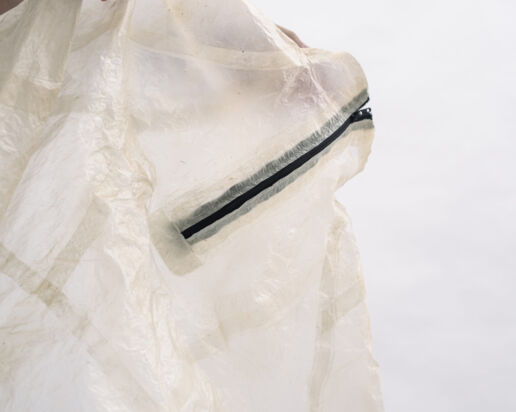
Animal skins, due to their properties, have been used by humans throughout history to create textiles with water-repellent capabilities. During a one-year research fellowship, WINT therefore investigated the aesthetic and functional design features of the skin of the goldbeater and sequenced the RNA. The goal: to synthetically replicate the material properties, develop a biopolymer and use it to make high- performance textiles. In cooperation with Mimotype
Technologies, a biotech start-up from Berlin, and funded by the BIOTEXFUTURE project of the ITA Institute of Textile Technology, the researchers succeeded in cultivating the unique material in bioreactors. The result is bio-synthetically grown collagen substrate – vegan and biodegradable – from which WINT has reated a running jacket that meets both aesthetic and functional demands.
While the global demand for synthetic textiles continues to rise and their production consumes large amounts of petrochemicals, energy and finite raw materials, a new generation of water-repellent outdoor jackets is thus born.
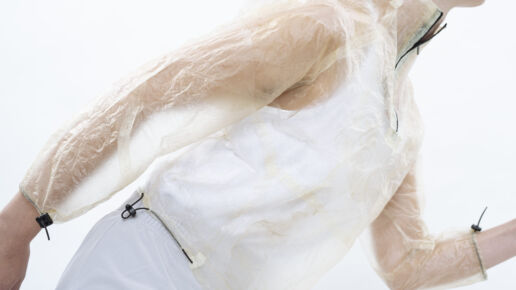
Source: GOLD
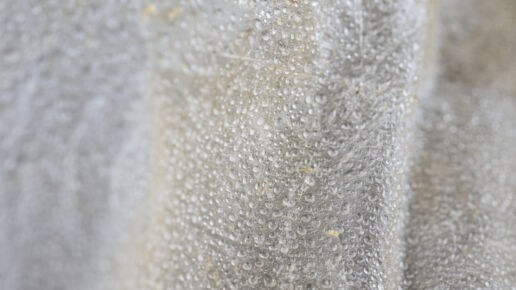
Source: GOLD
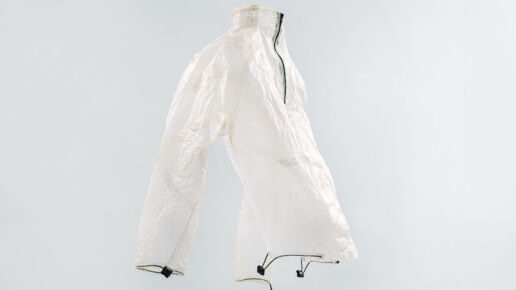
Source: GOLD
“As designers we have to shift the reasoning of our practice from convenience to impact.”
———————————————————————–
THIS MIGHT BE ALSO INTERESTING FOR YOU:
BioBase – Sustainable innovations
2. April 2024
The project targets the establishment of biobased polymers in the textile industry, demonstrating their full potential.
Fabric Trends Spring.Summer 25 – Part IV
28. March 2024
Summer, sun, well-being: Cooling materials such as cotton, linen, hemp is wanted as plain or combined qualities.
Blooming Minds – Sustainable Innovations
26. March 2024
Elizabeth’s research focuses on combining nature – especially the use of natural and recycled materials – and community, a social practice which weaves themes such as mental health while encouraging accessible creativity.
Let's get circular - Sustainable innovations
Using existing resources and creating something new from them: What if you didn’t dispose of the leftovers of freshly squeezed juice – but could create a new material from it? Germany is at the forefront of apple juice consumption, producing up to 200,000 tonnes of pomace per year, solid residues from the pressing process. Instead of reusing them, as has been the case up to now, mainly in biogas plants, for pectin extraction or as animal feed, textile and surface designer Verena Brom has been inspired to develop new material systems for various industries.
The designer studied at the Weißensee Art Academy in Berlin. In the project “A Matter of Fruit“, she produces various biodegradable films from pomace residues that can be used instead of synthetic material. Visually and characteristically, it can be classified as a paper, plastic or leather alternative, depending on its thickness, and offers potential for different areas of application – from interior design to the clothing industry. The material is suitable for laser cutting and engraving, but due to its fusibility it can also be welded or pressed into shape. In addition to the films, Verena Brom has developed a printing paste made from apple pomace that further expands the material’s design possibilities and areas of application.
After the first cycle of use, the material can be returned to the natural loop: For example, it can be turned into a plant pot that biologically decomposes after being potted into the soil. This brings Verena Brohm closer to her goal of using renewable resources – such as the by-products of the food industry – and to use design as a tool to optimise material cycles.
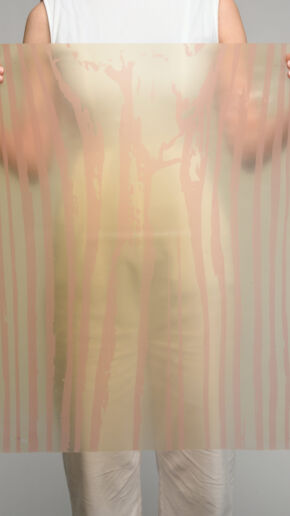
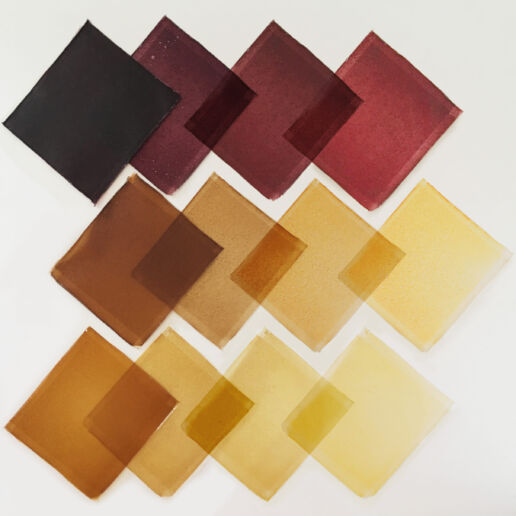
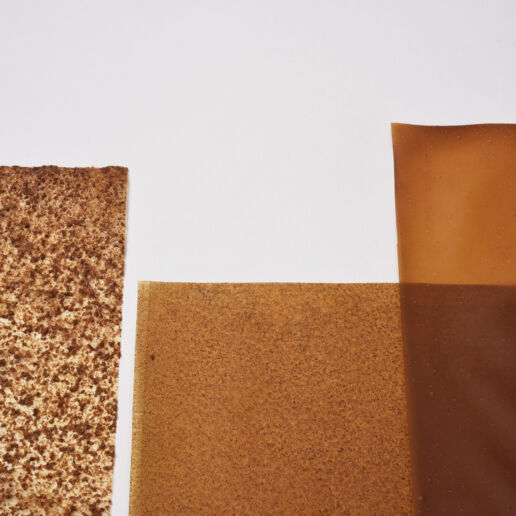
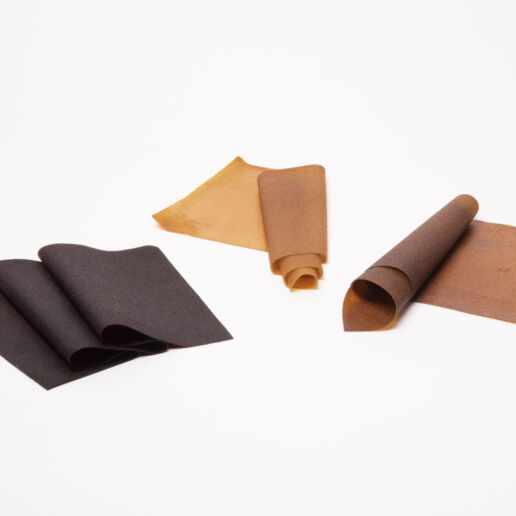
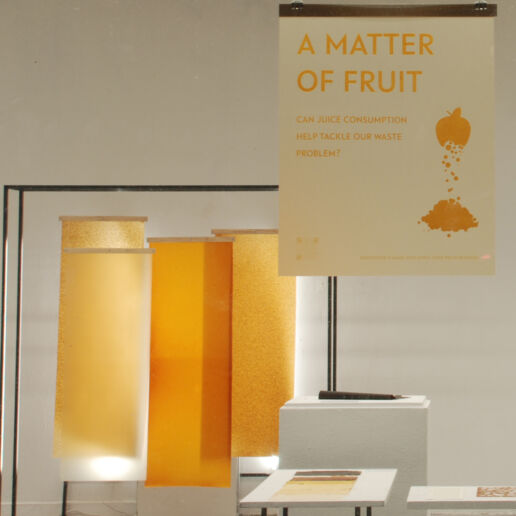
“When developing the material, it was important to use as few additives as possible – and to push boundaries:
how can different properties be developed solely through different processing methods? Using different techniques can expand the
scope for design and influences the haptic and translucency of the material:
from smooth to abrasive, from transparent to opaque – a big variety of options are possible without loosing the mono-materiality.“
———————————————————————–
THIS MIGHT BE ALSO INTERESTING FOR YOU:
BioBase – Sustainable innovations
2. April 2024
The project targets the establishment of biobased polymers in the textile industry, demonstrating their full potential.
Fabric Trends Spring.Summer 25 – Part IV
28. March 2024
Summer, sun, well-being: Cooling materials such as cotton, linen, hemp is wanted as plain or combined qualities.
Blooming Minds – Sustainable Innovations
26. March 2024
Elizabeth’s research focuses on combining nature – especially the use of natural and recycled materials – and community, a social practice which weaves themes such as mental health while encouraging accessible creativity.
The New World of Colours - Sustainable innovations
THE NEW WORLD OF colours
MycoColors by Birke Weber and Friederike Hoberg
SUSTAINABLE INNOVATIONS
Dyes play a major role in our daily lives – in the clothes we wear, the cosmetics we use or the food we eat. Most of the dyes we use are of synthetic origin, which poses potential health risks – both in the manufacturing process and in the dyeing process or use. In addition, dyes and pigments in industrial wastewater are not infrequently released into the environment, where they remain and damage ecosystems.
MycoColors, a project by designer Birke Weber and biochemist Friederike Hoberg, addresses precisely this problem. The two are researching the potential of alternative dyes – specifically: from fungi. With MycoColors, they want to develop optimal growth conditions for colour-producing mycelium with the aim of creating a sustainable extraction of dyes and an innovative dyeing process and establishing fungal dyes in the textile and fashion industry. Because: fungi offer a lively, broad colour spectrum that runs through all the colours of the rainbow and is far from being exhausted
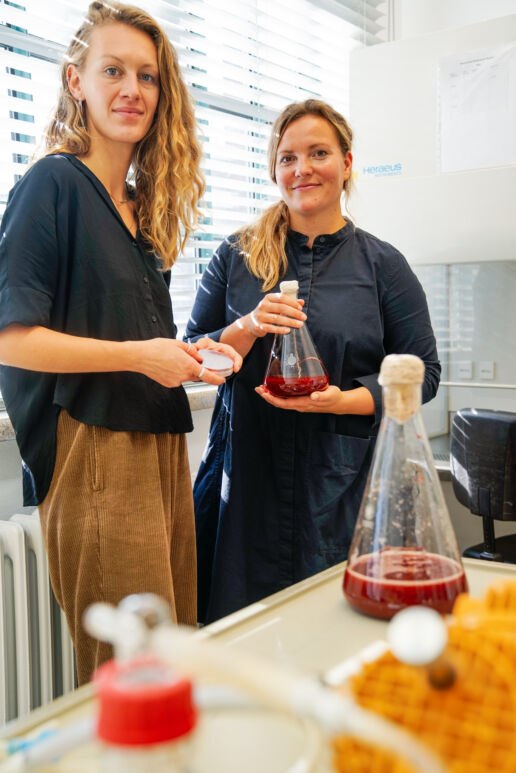

The advantages: The fungal mycelium from which the dyes are extracted grows within just a few days, cultivation takes place in inexpensive culture mediums and production is independent of weather and season. Furthermore, MycoColors works in a closed material cycle: resources such as water and nutrients can be recovered and reused, and by-products such as the biodegradable mycelium can either be returned to nature or upcycled – for example, by using it for paper production.
“The textile and fashion industry uses vast quantities of toxic and carcinogenic chemicals, including synthetic dyes, for its ever-changing
product range. But the end customers cannot trace everything that is hidden in a purchased T-shirt or carpet. A humane and environmentally
friendly alternative made from fungi aims to revise this uncertainty, especially with regard to the colors in a purchased product.”
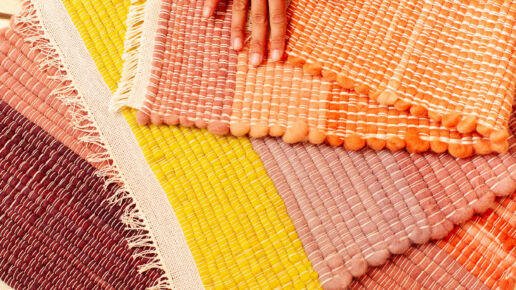
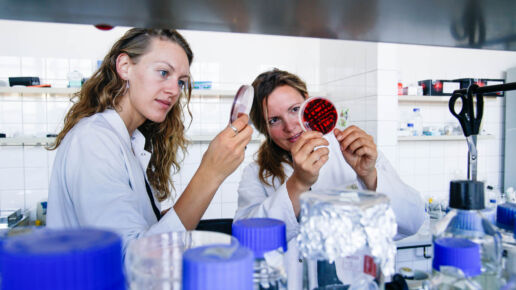
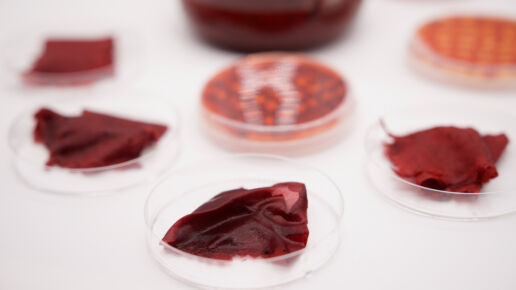
———————————————————————–
THIS MIGHT BE ALSO INTERESTING FOR YOU
BioBase – Sustainable innovations
2. April 2024
The project targets the establishment of biobased polymers in the textile industry, demonstrating their full potential.
Fabric Trends Spring.Summer 25 – Part IV
28. March 2024
Summer, sun, well-being: Cooling materials such as cotton, linen, hemp is wanted as plain or combined qualities.
Blooming Minds – Sustainable Innovations
26. March 2024
Elizabeth’s research focuses on combining nature – especially the use of natural and recycled materials – and community, a social practice which weaves themes such as mental health while encouraging accessible creativity.
Collective braiding - Sustainable innovations
A world where everything is becoming faster, more connected and more digital, endless possibilities are emerging. But why always strive for the new instead of continuing the traditional?
Designer Camille Champion has taken note of this development and, during a stay in South Korea, set out to revive interest in traditional craftsmanship.
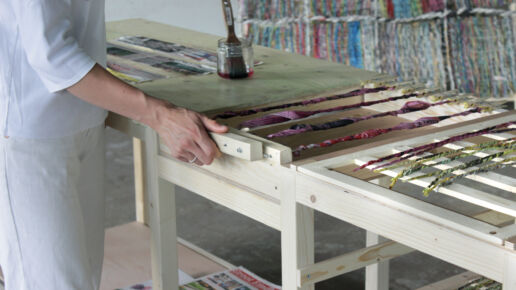
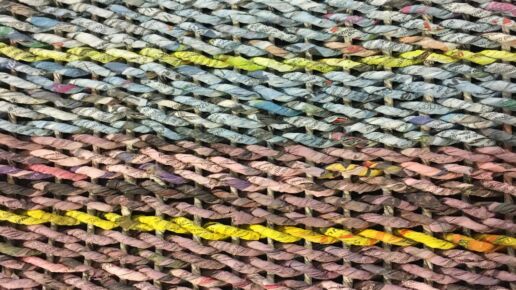
During her travels, she discovered the over 500-year-old technique of jiseung – a process dating back to the Joseon Dynasty that is used to make basketry from old books and paper waste. To do this, the paper is cut into thin strips and then corded. The cords can then be woven into containers such as baskets in various colours and patterns using different basketry techniques.
To save this cultural heritage from extinction, Camille Champion has launched the “Twist and Roll” project, bringing the reuse of newspaper waste to create new objects into a modern Western context: to pass on the craft, the designer has set up a series of workshops to give school children a connection to this tradition. She has designed a small weaving tutorial to teach children to make their own paper threads, weave them on a loom and then collectively build a tent-like structure for their classroom. Twist and Roll combines sustainability, creativity, craft skills and teamwork to show how the education system can benefit from crafts.
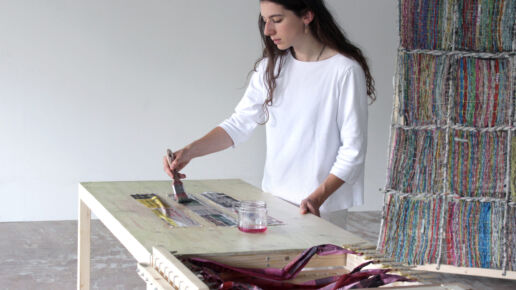
“In my opinion, giving the right tools to the new generations is very important.
Teaching them about materiality, history, or sustainability, will allow them to make the right choices for a better future.”
———————————————————————–
THIS MIGTH BE ALSO INTERESTING FOR YOU
BioBase – Sustainable innovations
2. April 2024
The project targets the establishment of biobased polymers in the textile industry, demonstrating their full potential.
Fabric Trends Spring.Summer 25 – Part IV
28. March 2024
Summer, sun, well-being: Cooling materials such as cotton, linen, hemp is wanted as plain or combined qualities.
Blooming Minds – Sustainable Innovations
26. March 2024
Elizabeth’s research focuses on combining nature – especially the use of natural and recycled materials – and community, a social practice which weaves themes such as mental health while encouraging accessible creativity.
Clothes that grow - Sustainable innovations
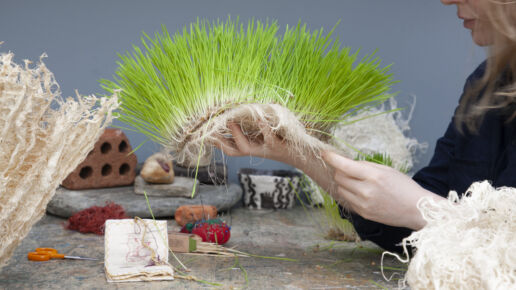
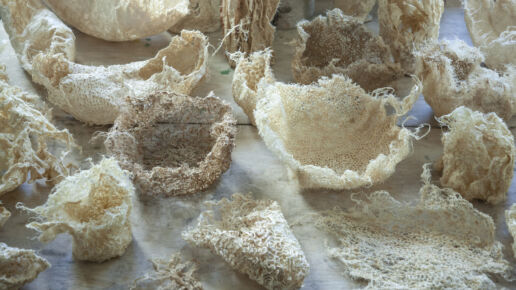
Nature as a 3D printer: material designer and underwater photographer Zena Holloway creates shapes and forms from wheat grass roots that grow in self-carved moulds made of beeswax. The supposed magic lasts for twelve days – the roots spread out horizontally or vertically and make their individual way through the wax templates. Depending on the shape of these, the roots either grow small in a confined space so that they become flat and compact, or if there is more space they can root deeper and three-dimensional shapes emerge. Immediately after harvesting, the roots are heavy and moist, after 24 hours they dry out and become light as a feather.
Each growth cycle produces a different result – all products are therefore individual pieces that can be further shaped by cutting, sewing, tearing or linking. For example, they can be used to create large, hanging structures, to shape vessels or to produce clothing and accessories. The wheatgrass roots also react particularly well to natural dyeing processes. In the name of sustainability: the water that accumulates and runs off during production can be reused and the leftover shoots, seeds or roots can be reused as animal feed. In addition, the dried root is a kind of botanical skeleton that binds carbon. Thus, the Rootful project demonstrates a micro-level approach to solving the complex problem of climate change.
“Growing artefacts from root is the simplest concept but captures the imagination of a wide audience.
I’m learning that root is a wonderful material to create fashion and art, serving to open up conversations around materiality and sustainability that inspire change.“
In the name of sustainability: the water that accumulates and runs off during production can be reused and the leftover shoots, seeds or roots can be reused as animal feed. In addition, the dried root is a kind of botanical skeleton that binds carbon.
Thus, the Rootful project demonstrates a micro-level approach to solving the complex problem of climate change.
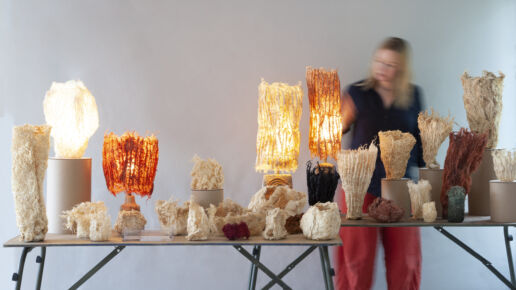
———————————————————————–
THAT MIGHT BE ALSO INTERESTING FOR YOU
BioBase – Sustainable innovations
2. April 2024
The project targets the establishment of biobased polymers in the textile industry, demonstrating their full potential.
Fabric Trends Spring.Summer 25 – Part IV
28. March 2024
Summer, sun, well-being: Cooling materials such as cotton, linen, hemp is wanted as plain or combined qualities.
Blooming Minds – Sustainable Innovations
26. March 2024
Elizabeth’s research focuses on combining nature – especially the use of natural and recycled materials – and community, a social practice which weaves themes such as mental health while encouraging accessible creativity.


